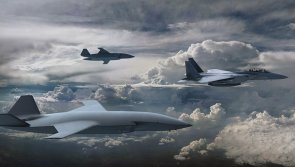Anduril develops new Roadrunner drones that it says can perform air defense missions

Autonomous technology manufacturer Anduril has created a new high-speed drone, including a variant that company executives say can intercept and destroy enemy aircraft.
The uncrewed system, dubbed Roadrunner, is a “twin-jet powered autonomous air vehicle” that can take off and land vertically and fly at “high subsonic speed,” according to a press release provided to reporters ahead of Friday’s announcement.
“The modular payload system can carry a variety of constantly-updated payloads to accomplish broad sets of missions and can constantly be updated to meet the threats of tomorrow,” it said.
A version of the unmanned aerial system called Roadrunner-Munition (Roadrunner-M) is a “high-explosive interceptor” that’s intended for air defense, per the release.
“Roadrunner-M is the thing that is today, you know, effectively a kamikaze craft when you actually want to use it. If you decide that it is going to take out the [threat], then yeah, it takes itself out,” Anduril founder Palmer Luckey told DefenseScoop during a teleconference with reporters this week ahead of the official unveiling.
The new drones could have a variety of use cases, according to executives.
An anti-air mission could include going after “a really dangerous, high-speed, high-maneuvering, jet-powered threat aircraft,” Luckey told reporters. “But there’s a lot of different payloads we could put on Roadrunner to go after different vehicles, different targets in different domains — some of them as a one-way mission, some of them in a totally reusable capacity. And that’s across air, that’s across sea, that’s across land, that’s even across the electronic domain using some of the electronic warfare payloads that we’ve developed here at Anduril for other applications that our customers are using right now.”
The UAS could be used to take out unmanned aerial systems, he noted, although they would be best-suited to attack larger-sized unmanned aerial systems, not small systems like quadcopters, he suggested.
A kamikaze drone like the Iranian-built Shahed that’s being used against Ukraine “is kind of at the low end of what you would be able to prosecute with a Roadrunner. Roadrunner can go all the way up to Group 4-5 UAS, and really full-sized aircraft as well,” he said.
The cost per air vehicle is currently in the “low hundreds of thousands” of dollars, according to Luckey, but the company expects the price tag to come down once it goes into large-scale production.
Anduril executives highlighted that the systems are reusable. If they are sent out on a mission but don’t carry out a kamikaze attack or get destroyed, they can be recalled, landed, refueled and relaunched. Some of the company’s platforms already have conducted dozens of flights during testing, according to Luckey.
The company plans to increase its autonomous capabilities.
“In order to operate systems in high volume to go against a high-volume threat, you have to make this a less … manpower-intensive operation. You have to push greater amounts of autonomy onto the air systems themselves. And we’re at the very beginning of that journey. You know, I would not overstate it by any means, but the system is fundamentally built as an autonomous air vehicle. And that’s a key characteristic of it. But we’ll continue to build out moving forward so that you can get to multi-ship operations, collaborative operations, those kinds of concepts of operation,” Chris Brose, Anduril’s chief strategy officer, told reporters.
The platform has onboard processing and onboard sensors that allow it to find targets, calculate an optimal intercept path, and then engage the target. However, it can also be integrated with other fire control systems and sensors that can “cue” the drone, according to Luckey.
The company developed Roadrunner on its own dime, a process that kicked off about two years ago. The contractor already has a U.S. customer for the system, according to executives, but they declined to identify it in the call with reporters.
“We have to be careful about what we say. It’s not because I don’t want to talk about it, it’s because it’s sensitive information. But it does have a customer, it’s been operationally assessed, and we’re going into low-rate initial production imminently. And that’s going to be in the hundreds of units. And the intent is that we quickly scale into the thousands of units,” Luckey said.
Company officials also declined to disclose the exact range of the platform and some other key details, such as its top speed and the size of the payloads or warhead it could carry.
“What we can tell you is it’s capable of high subsonic flight. It’s capable of high-G maneuvering … It’s capable of going up against a wide range of targets including and up to full-size aircraft. You have to be able to carry enough payload to make that possible,” Luckey said.
However, it doesn’t seem to have the characteristics that would fit the bill for the Air Force’s collaborative combat aircraft (CCA) program, which aims to develop next-generation drones that could serve as robotic wingmen to manned fighter jets and also operate independently. Service officials have said they expect CCAs to have about the same range of today’s fighter jets, or perhaps a little more.
“Unfortunately, it’s not going to be able to be a CCA. It doesn’t really fit into that. Roadrunner is shorter than me … so it’s a very, very small system with a very, very small automated hangar,” Luckey told DefenseScoop during the call with reporters. “I would love it if we could get the ranges and payloads necessary to be … a CCA. But unfortunately, Roadrunner doesn’t have the legs.”
However, company leaders say it could potentially help meet the needs of the Pentagon’s Replicator initiative, which has a goal of fielding thousands of autonomous systems of various types in less than two years. Deputy Secretary of Defense Kathleen Hicks announced the Replicator effort in August.
“We’ve been engaged with them since the start on that,” Luckey told DefenseScoop during the teleconference with reporters. “This, along with a bunch of other things that we’re building, are directly applicable to the thinking of Replicator, which is how do we build at scale autonomous systems and field them extremely quickly in scale that matters? And Roadrunner and a few other things that Anduril is building, some of which are public, some of which are not, are all oriented at what Replicator is trying to do.”
Brose added: “I can easily see how Roadrunner would fit a lot of the needs that Replicator has, to the extent that I understand the intent of Replicator. But whether it’s something that the department would actually want to employ as part of Replicator is going to be for them to decide.”






